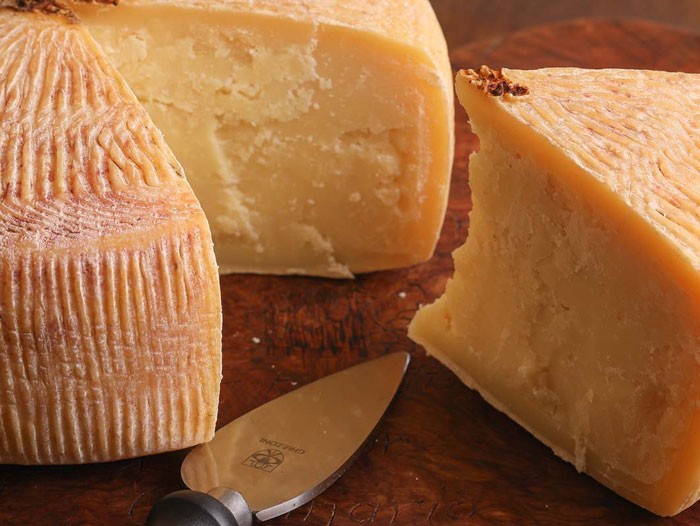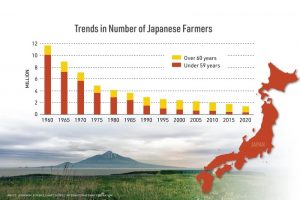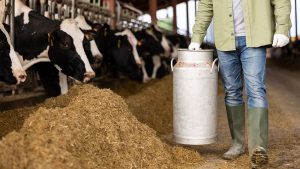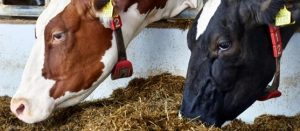
One glimmer of light is the jump in production of matured cheeses by Hokkaidō’s cheesemakers, generating rising demand for milk. This may be the key to saving Hokkaidō’s dairy farmers.
Boosting Cheese Production to Help Dairy Farmers
Fattoria Bio Hokkaidō in Sapporo’s Shiroishi Ward is dedicated to making and selling quality cheeses rivaling those of Italy. Since March 2020, the shop has been working to produce a high-quality cheese named Grana di Ezo that will be matured for eight months before sale.
Takahashi Hiroyuki, president of Fattoria Bio Hokkaidō, explains how the decision to produce a matured cheese came out of the pandemic.
“The coronavirus pandemic has caused dairy farmers to lose a lot of their business with school lunch providers and the food and beverage industry. We have also been affected. We can no longer offer cheese tastings at our shop in the Chitose Airport, orders from restaurants have dwindled significantly, and department stores have had to cancel their Hokkaidō specialty fairs. We really need a product that will not only improve things for us but for dairy farmers as well.”
Fattoria Bio Hokkaidō is best known for its offerings of fresh cheeses like mozzarella, ricotta, and burrata. “Fresh cheese is like tofu,” notes Takahashi. “It tastes best when it’s just been made.”
Unfortunately, the coronavirus has made it impossible to directly sell these kinds of fresh cheeses. If cheese production stops, then orders for fresh milk plummet, a devastating situation for dairy farmers.
A Big Gamble
Takahashi has decided on putting everything his company has into full production of matured cheese at a time when demand is down.
“We were already producing small lots of matured cheese, but it was always a rare item reserved for only those in the know. We’ve changed that policy to make matured cheese our primary product. With this change we will be able to continue buying milk even after the spring and operating at full capacity.”
Takahashi is betting the company will come out on top by undertaking this challenge.
“Grana di Ezo is very much like Grana Padano, a popular matured cheese in Italy. It is, of course, delicious on its own, but can also be grated over salads and pasta, and adds great flavor to soups and stews. This is a wonderful everyday cheese that can be used as a mainstay in any Japanese kitchen, just like miso and soup stock.”
Grana di Ezo is mild without having a milky taste, but it gradually fills your mouth with a rich, full-bodied flavor. This flavor is enhanced when the cheese is used as an ingredient in cooking and is well-suited to the Japanese palate.
Cheese Shops a Boon to Dairy Farmers
Milk production has been declining for some time on a nationwide basis. Hokkaidō, however, which accounts for over 54% of Japan’s milk production, produced 3.92 million tons in fiscal 2017, a slight increase over the preceding year. This figure continued to rise as dairy farmers expanded their facilities and implemented strict quality control measures.
Processed milk products, particularly cheese, have been doing well. There were just 106 cheesemakers in Japan in fiscal 2016; today the number has increased to 319, and nearly 40% are located in Hokkaidō.
The majority of these cheesemakers are directly operated by dairy farms and have been hit hard by the curtailed tourism and economic crunch caused by the coronavirus pandemic. Not a few of these cheesemakers lament that the pandemic has set them back just when business was looking good.
Cheesemaking has been touted as a symbol of a growing “sixth industry” of agricultural production, but while dairy farmers have been able to expand their milk production to include cheesemaking, they have come in for some warranted criticism with respect to their poor efforts in the areas of sales and publicity.
The situation is a little different for Fattoria Bio Hokkaidō, however. “My career has actually been in branding and marketing,” says Takahashi. “I never dreamed I would get involved in cheesemaking until we established the company in 2013.”
From Marketing to Cheesemaking
One of Takahashi’s marketing achievements was a collaborative project with the Sapporo Maruyama Zoo in Sapporo to promote the Polar Bear brand of “Ripe ’n’ dry Salt Ramen.” The product has been selling at a rate of 600,000 packages a month.
“It was Elio Ermanno Orsara, my business partner, who got me involved in cheese,” says Takahashi.
Elio Orsara is the owner-chef of Elio Locanda Italiana, a restaurant in Tokyo’s Kōjimachi district that Takahashi was in the habit of visiting on his trips to the city. One day, Elio approached Takahashi with a proposal: “Japan doesn’t have the kind of delicious cheese I ate as a child in Italy. Maybe we can work together to produce a cheese in Japan that can stand up to its Italian rivals.” Apparently, Elio already had high confidence in Takahashi’s abilituy to pull off such a project.
Italian Craftsmanship and Top-Quality Raw Milk
“We started with a search for raw milk with quality just as high as any that might be found in Italy. It took us nearly five years, but we finally found what we wanted in my homeland of Hokkaidō,” says Takahashi.
Elio says, “Hokkaidō milk is among the best in the world. We knew with this milk we could make cheese just as good as any in Italy.” No time was lost in recruiting experienced Italian cheese master Giovanni Graziano to work in Japan. Graziano also saw great potential in the quality of Hokkaidō’s dairy output.
Graziano left his family behind in Italy to join the project in Japan. The cheese master says, “Our naturally made cheeses condense all the flavor of the best Hokkaidō milk. I want everyone in Japan to enjoy the great taste of our cheeses. We use no fungicides and we do not coat our products with chemicals. All our cheeses are carefully nurtured with tender loving care.”
Graziano’s made-in-Japan cheeses were very quickly awarded medals for their high quality in domestic contests. Today they enjoy the strong support of Japanese cheese aficionados. When the company decided to produce a mature cheese, it was Graziano who suggested it be named “Ezo,” the old name of Hokkaidō, as a mark of appreciation to the region.
Grana di Ezo was made possible with crowdfunding. The project, says Takahashi with pride, “reflects the generosity of people throughout Japan who want to save the Hokkaidō cheesemakers, and particularly the dairy farmers, from the economic impact of the coronavirus pandemic.”
The crowdfunding drive exceeded its original goal of ¥500,000 by nearly five times, bringing in a total of ¥2.34 million. Contributors are now looking forward to their shipments of the cheese that has been maturing over the past eight months. There is also a steady increase in online sales. Still, Takahashi hopes for more.
“We are getting a lot of support from luxury grocery stores with eat-in sections and from supermarkets specializing in the delivery of organic foods and natural foods without additives. I am hoping we can continue to expand our sales routes in this way.”
Will Takahashi succeed with matured cheese as he did with the marketing of an instant ramen brand? Everyone, especially Hokkaidō’s dairy farmers, are watching with eager anticipation.
Fattoria Bio Hokkaidō website (available in Japanese only): https://fattoriabio.jp/
(Originally published in Japanese. Banner photo: Blocks of limited production Grana di Ezo first made in 2017. In the COVID-19 pandemic, Fattoria Bio has switched to full-line production of cheese matured for eight months before delivery. Photo courtesy of Fattoria Bio Hokkaidō.)




















